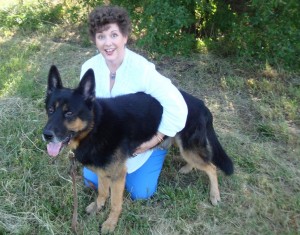Adopt-A-Senior Pet Month
Guest post by Amy Shojai
November is Adopt-A-Senior-Pet Month. My first German Shepherd lived to 13 years, and now Magical-Dawg is 9, and Seren-Kitty will soon be 20 (yikes!), I can attest that the golden oldie pets are wonderful choices for many folks. It makes me proud but a little sad, too, that both my Seren-Kitty and my GSD serve as furry models in my books Complete Care for Your Aging Cat, and Complete Care for Your Aging Dog.
Sure, there are some behavior changes in older pets, but cats and dogs don’t count birthdays. There are simple ways to help these furry wonders stay youthful. There’s lots of reasons to adopt a senior pet.
Too often, folks become entranced by the cute-icity of baby pets, and then discover the challenges of that youngster making mistakes while they learn the rules. When you adopt a senior citizen dog or cat, all the hard work is done.
Your newly adopted senior dog has already learned not to chew the TV remote control or your shoes, except for the “legal” old house slipper she arrived with from her mysterious past life. She may have carried it around like a teddy bear for the past ten years. She’s been housetrained and tells you when she needs to “go”—and you know just how many hours you can be away from home before she’s in dire straits.
A senior kitty no longer climbs the Christmas tree, unrolls the toilet paper, or swings from the drapes. He got all those juvenile delinquent kitten hijinks out of his system long ago. He knows not to excavate the potted palm or play ping-pong with the parakeet. You’ll know in advance if he still loves to rearrange sock drawers when bored, adores (or despises) dogs, gets along with other cats and loves lap sitting or bug chasing.
An older pet reminds you when it’s time for a pill and afternoon nap—for both of you. And she acts like your new grandbaby belongs to her, and showers the infant with attention, gentle play, and protective care—even putting up with toddler tail tugs with a patient purr or doggy grin. Countless children have learned to walk while grasping the furry shoulder of a canine friend, or reaching out for that tempting feline tail. Of course, you supervise and protect your furry partner so the human baby learns the rules, too.
Adopting a mature pet can be a great choice for children. They can be a stabilizing influence, teach responsibility and empathy for other living creatures, and even act as a bridge toward making friends. For example, a child shy of interacting with other kids because of a perceived disability often comes out of her shell when accompanied by a furry friend. The pet remains the focus of interaction rather than the child’s “different” look or behavior. These therapy animals, called “social pets,” have an important job to do, just by offering nonjudgmental love and acceptance.
Even when pets are not officially a “therapy” animal, cats and dogs who have spent many years with us have learned what we like and expect—and we’ve learned to anticipate the senior pet’s needs, likes, and dislikes. We build and then enjoy a comfortable companionship together. After sharing our life experiences, successes and failures, joys and sorrows, these pets come to represent milestones in our lives. They may have celebrated with us when we graduated school, married, and had children or grandchildren—or comforted us when we divorced, retired, the kids moved away, or we lost a spouse.
Adopting old dogs and cats also saves a life. These needy old-timers have so much to give, and seem to pack an incredible amount of love and laughter into even a half dozen years with us. Dogs and cats are longer lived today than ever before. Just look at Seren-Kitty; I could have adopted her as a senior cat at age 10, and still enjoyed another decade with her.
 Old pets want to be there for us, through everything. And we return the favor. The more time we spend together, the greater our affection grows. Our compassion, love, and empathy for each other reach a depth that has no parallel in human existence.
Old pets want to be there for us, through everything. And we return the favor. The more time we spend together, the greater our affection grows. Our compassion, love, and empathy for each other reach a depth that has no parallel in human existence.
Amy Shojai is a certified animal behavior consultant, a former vet tech, and author of more than 30 pet care books. You can learn more at her Bling, Bitches & Blood Blog.



